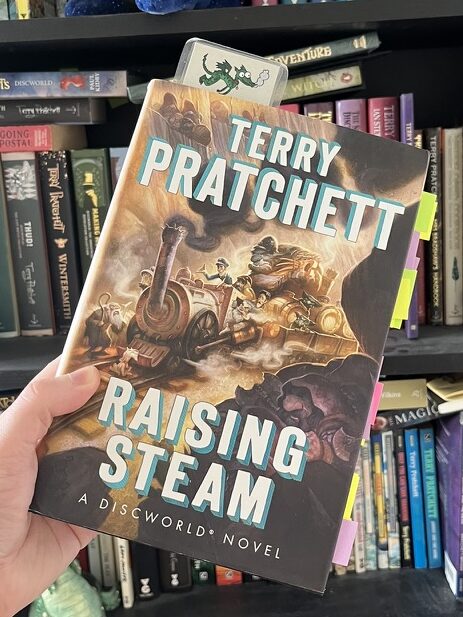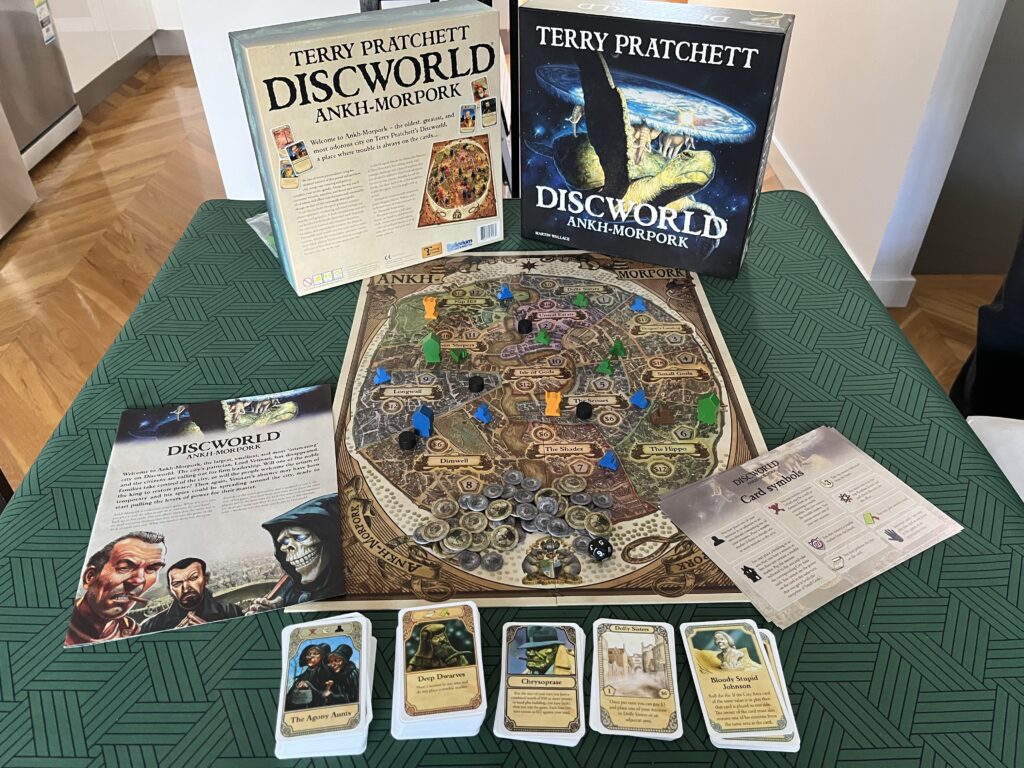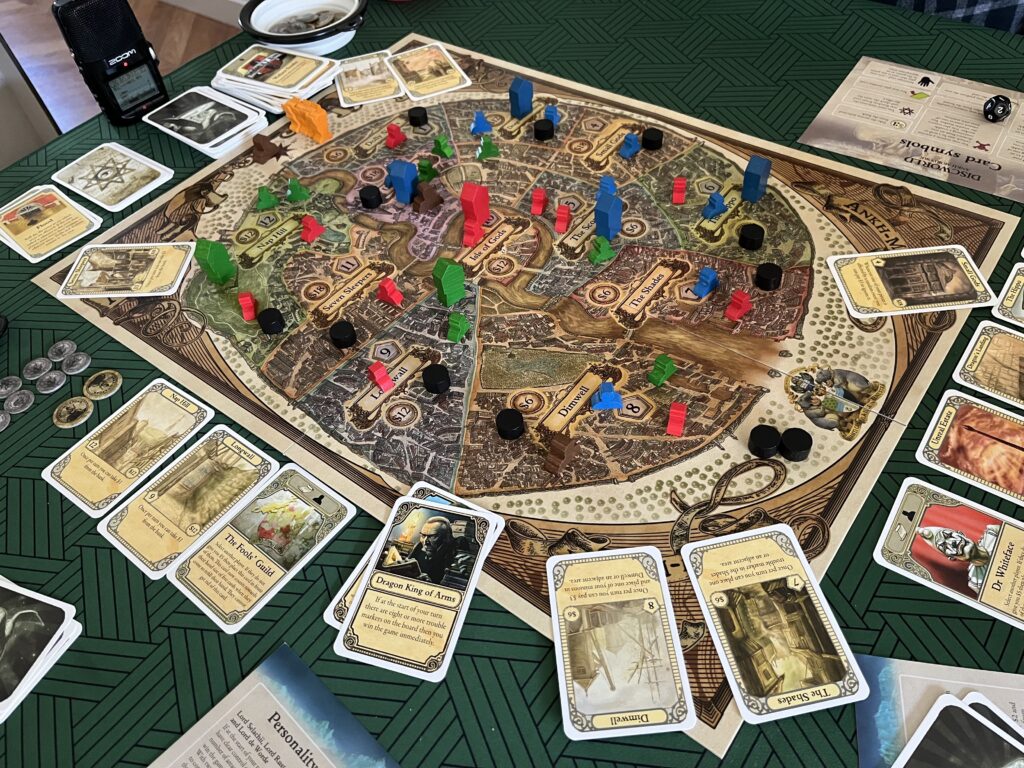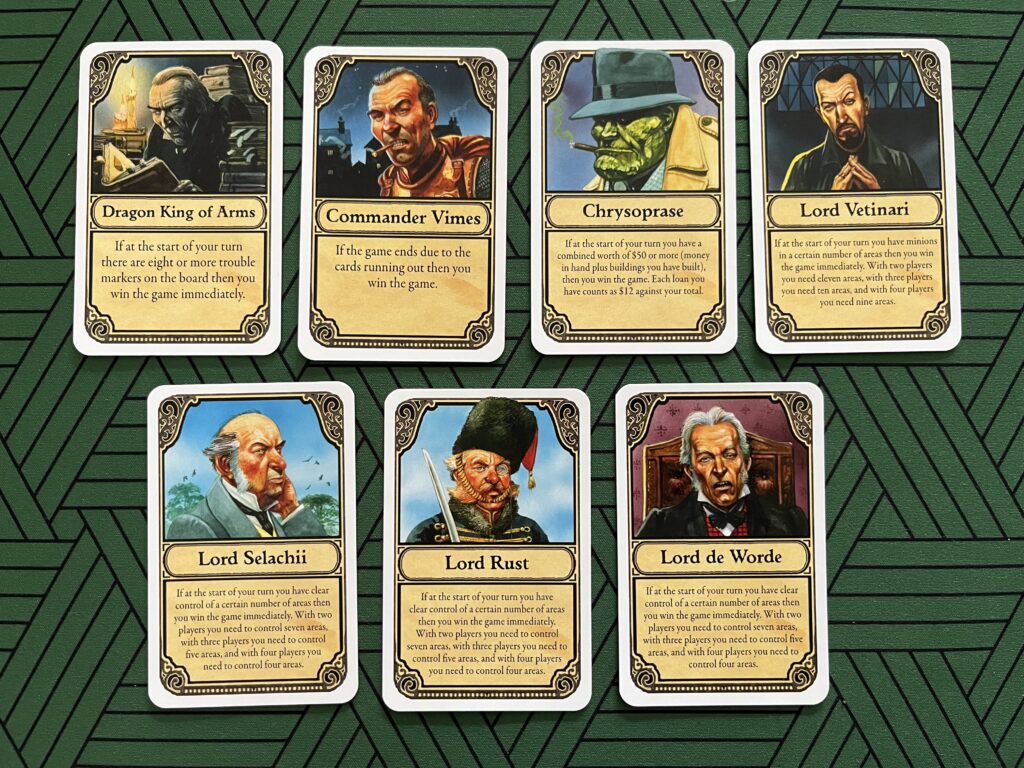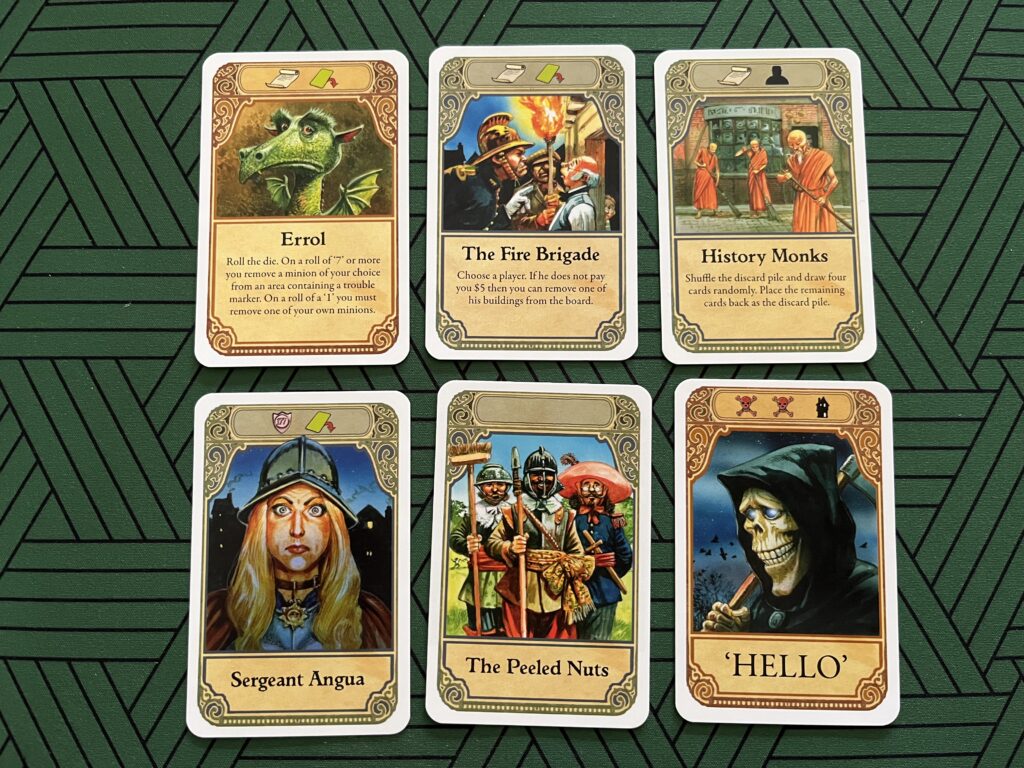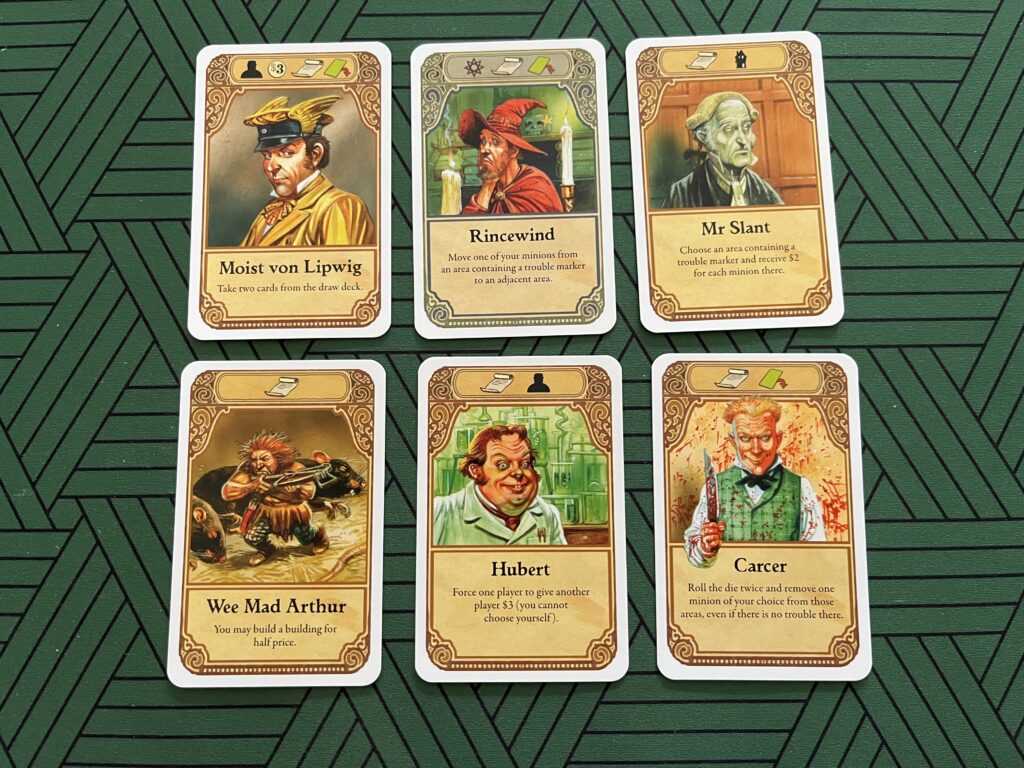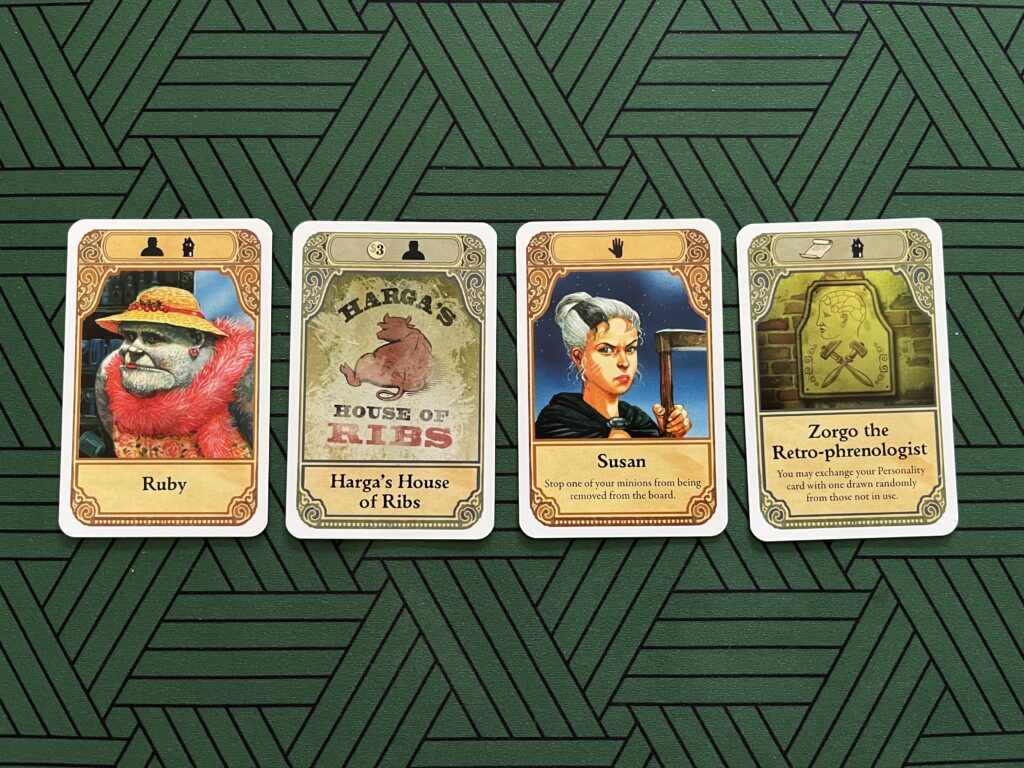These are the episode notes and errata for Pratchat episode 56, “do { Podcast(); } while ( unreadPratchetts > 0 );“, discussing the 1990 short story “#ifdefDEBUG + ‘world/enough’ + ‘time’” with guest Sean Williams.
Iconographic Evidence
Conspicuously missing from this section is that illustration from the German collection Der ganze Wahnsinn: Storys, but despite what much of the Internet is like it’s not actually okay to publicly share artwork without the artist’s permission.
However, it does appear in the picture section of A Blink of the Screen! There is presented the full, original artwork, which was painted for the cover of a 2001 German anthology of short stories, Retter der Ewigkeit, subtitled “Geschichten zwischen Diesseits und Jenseits” (roughly “Saviour of Eternity: Tales between this world and the afterlife“). This version shows the whole scene – unlike the versions used for either of the German collections – and answers a few of our questions, especially that the yellow leg is indeed that of Michael Dever in his AR chair. In the ebook edition it’s presented at quite a low resolution, and sideways (in the print edition it’s a double-page spread), which might be why Ben thought it was familiar but didn’t recognise where he’d seen it.
While it’s not amongst the images available on Josh Kirby’s official website, if we find it somewhere else public, we’ll point you to it. Sven and Ben have both shared the versions they have via the Pratchat Discord, so subscribers with access can see it there.
Notes and Errata
- The episode title is valid C++ code, assuming that the function Podcast exists and updates the value of unreadPratchetts to avoid the podcast going on forever. Or is that what you all secretly want?
- Philip K. Dick (1928-1982) – who’ll be mentioned quite a bit this episode – was an American science fiction author, many of whose novels and short stories have been famously adapted for the screen. These include The Man in the High Castle, Do Androids Dream of Electric Sheep? (adapted as Blade Runner), “We Can Remember It For You Wholesale” (adapted twice as Total Recall), “The Minority Report” (more about that in another note) and A Scanner Darkly, among others.
- You can hear Sean’s episode of Splendid Chaps, “Three/Family“, over at the Splendid Chaps website. It was recorded on Sunday, 10 March 2013, at the pop-up Adelaide Fringe venue the Tuxedo Cat, and released on 23 March 2013.
- Strata was Pratchett’s third novel, first published in June 1981, about two and a half years before The Colour of Magic. It’s features a science fiction version of the Discworld – a planet shaped like a flat disc, which seems to have been built by ancient aliens. It’s more-or-less a parody of Larry Niven’s popular Ringworld books, with many specific jokes and references. But we’ll say no more about it here, as we’ll definitely be covering it on the podcast in future.
- The Ferals (1994-1995) was an Australian children’s television program on the ABC starring a mix of humans and puppet animals: Rattus, a rat; Modigliana, a feral cat; Mixy, a rabbit (her name is a pun on myxomatosis, a disease used to control wild pest rabbits in Australia); and a “dopey dog”, who it turns out is both not a dingo and not a Darren – his name is actually Derryn. While the original show only ran for two seasons, the puppet characters were very popular and continued to host and appear on other shows for several years. This included the five-minute Feral TV, in which the ferals ran a television station headed up by Kerry the Cane Toad (a clear parody of Kerry Packer, then owner of Australia’s Channel 9 TV network) and his assistant Rodney, a cockroach.
- The story was written for the 1990 anthology Digital Dreams, edited by British writer, editor and sociologist specialising in religion, David V. Barrett. Barrett has a long history editing and writing for speculative fiction and similar magazines, including Vector and the Fortean Times. He also edited Tales From the Vatican Vaults, a collection of short fiction based on the premise of secret Vatican files being released to the public in an alternate history where Pope John Paul I reformed the Catholic Church. It was published in 2015, and features a few stories by authors who contributed to Digital Dreams. As we discussed, authors in the collection include Neil Gaiman, Diana Wynn Jones, Dave Langford, Storm Constantine, Ian McDonald, Keith Roberts and Andy Sawyer. You can see the cover and full list of authors at the book’s entry in the Speculative Fiction Database (SFDB).
- The short story commentary in which Pratchett says “short stories cost me blood” and “I doubt I’ve done more than fifteen in my life” is “The Sea and Little Fishes”, which we discussed in #Pratchat39, “All the Fun of the…Fish?” The book in which this commentary appears, A Blink of the Screen, contains thirty-two short pieces of fiction. Admittedly, a few of those don’t really count as stories – see #Pratchat53 for three examples – but that’s not counting the four volumes of his early short stories for children, published separately.
- Neil Gaiman’s short story about the troll under the bridge is titled, er… “The Troll Bridge” (or sometimes “Troll-Bridge”). It seems to have been first published in the short story collection Snow White, Blood Red in 1993, two years after the first publication of Pratchett’s story of the same name. The story was nominated for the World Fantasy Award in 1994, and has appeared in a few other places, including Gaiman’s own anthologies Angels and Visitations (1993 – probably the collection Sean is thinking of), Smoke and Mirrors (1998) and M is for Magic (2007), and was adapted into the comic book Ben read in 2016 by Colleen Doran. While he was certainly better known as a comics writer at the time, Gaiman had written and published several short stories by 1990, though his most famous short fiction came after Digital Dreams. One of his notable earlier stories is 1984’s “We Can Get Them for You Wholesale” – the title clearly riffing on Dick’s “We Can Remember It For You Wholesale” – about a young man who finds an assassin in the phone book and discovers they do bulk discounts, a very Pratchetty idea.
- We discussed “Once and Future“, Pratchett’s 1995 short story for the collection Camelot, in #Pratchat49, “Once More, With Future“.
- The “internal monologue” is the way many people think to themselves: in words. But while common, this is far from a universal experience – and most people assume others think in the same way as they do. Finding out otherwise often blows people’s minds, as with the cascade of articles and viral social media posts that cropped up in the way of this 2020 tweet:
- “Atari” was never that widely-used as a synonym for game consoles, but “Nintendo” was – which is why some sources credit them with aggressively re-popularising the still fairly new generic term “game console” in the 1990s, so they could hang on to the trademark. It worked! And while some folks did (and do) use “Playstation”, “XBox” or even “Game Cube” as a stand-in for game console, those never became as widespread. (Earlier consoles were referred to as “game systems”, but by the time Nintendo massively dominated the market in the early 1990s, “console” – which differentiated a dedicated system for games from a more versatile personal computer, and from an arcade “cabinet” that could only play a single game – had become the preferred term.)
- Genericisation can indeed make a product’s name ineligible as a trademark. This process is also known as “trademark erosion” or “genericide”, and in America – where most of the famous cases have occurred – it’s controlled by the Lanham (Trademark) Act. The Lanham Act allows a registered trade mark to be cancelled if it “becomes the generic name for the goods or services, or a portion thereof, for which it is registered”. In Australia, the Trade Marks Act 1995 has a similar clause: the mark can be cancelled if it “becomes generally accepted within the relevant trade as the sign that describes or is the name of an article, substance or service”. This has happened to some significant and surprising things: Aspirin and Heroin were both once trademark names used by the Bayer company! To protect against this modern drugs are often given a specific, non-proprietary name, with different company’s specific versions having trade names as well. Other famous examples include cellophane, dry ice, escalator, kerosene, laundromat, videotape and zipper! Examples like Hoover, Kleenex and Google (see below) have certainly become generic terms for a kind of thing, but not to the extent where a trademark has been revoked or expired. In Australia, the legal test seems to be whether the trade mark has become the only term used for a product or service.
- The Google company went through a major restructuring in 2015 with the creation of Alphabet Inc, a new company which owned Google (the Internet services company that runs the search engine, GMail, YouTube and various other online services) and several other companies that were previously subsidiaries of Google. The driver behind this wasn’t a worry about genericisation; rather Google stated that wanted to make the company more accountable and give subsidiaries more freedom. But Google is commonly used to mean “search the Internet”, including as a verb (“I googled it”), and this has come up in court as a reason to cancel the trademark, as per the Lanham Act mentioned above. In 2017, a case in Arizona set a new precedent that the test for genericisation was whether the “primary significance of the trade mark in the minds of the consuming public” had become the product, rather than the producer. They ruled that while people did use “google” as a verb, they also understood Google was a company and not the only way to search the Internet.
- Amstrad was a British computer company created by English tycoon and politician Alan Sugar. It operated between 1968 and 2010, and was most famous for their personal computers in the 1980s and 1990s. These included later iterations of the ZX Spectrum, which Amstrad bought from its original creator Sinclair Research, and the Amstrad Mega PC, a Windows-PC which also had a built-in Sega Mega Drive game console (known as the Sega Genesis in the US).
- Hitachi is a Japanese company founded in 1910, which has grown into a conglomerate best known for their technology products. They no longer make personal or mainframe computers, but do make everything from military vehicles to air conditioners and the Hitachi Magic Wand, a “vibrating massager” introduced in 1968 which experienced a huge swell in sales when it featured in a 2002 episode of Sex and the City.
- The 1980s-style retro-VR cyberpunk videogame trailer Ben remembered was for the game Jazzpunk, released in 2014. You can watch the live action Jazzpunk trailer on YouTube.
- William Gibson’s Neuromancer, one of the first and most influential cyberpunk novels, was first published in 1984, so around six years before Pratchett wrote “#ifdefDEBUG + ‘world/enough’ + ‘time'”. Neuromancer popularised many terms and concepts which are now essential parts of the genre, and it’s also the only novel ever to have won the Nebula, Hugo and Philip K. Dick Awards.
- “Carnie” is an American nickname for “carnival worker”; the traditional Australian equivalent is “showie”, short for “showman” or “showwoman”, since we call them “shows” rather than carnivals. We previously talked about this in #Pratchat51, where our previous research suggested the Australian term might even be a little older than the American one. (The surname in this story – and, most of the time, in real life – is spelled “Carney”.)
- We dance around this a little in the episode, but clues in the story suggest that “Seagem” – the name for the artificial reality company that becomes a generic name for AR machines – comes from the acronym CGEM, which probably stands for “Computer Generated Environment Machines”.
- The term AFOL, an acronym for “Adult Fan of Lego”, can be traced back to the newsgroup rec.toys.lego, where it was first coined by Matthew J. Verdier on the 14th of June, 1995 after another user, Jeff Thompson, was the first to use the phrase “adult fan of Lego”. It was a niche term for a decade or so, but in the 2010s not only had more people who grew up playing with Lego returned to it as adults, but the Lego company themselves realised there was a whole underserved market of adult Lego fans, and started making sets which would appeal to them. Unlike some other niche adult fandoms for things traditionally seen as “for kids”, the AFOL community often mingle with and involve young Lego fans too, and you’ll see whole families at Lego conventions, in stores and at events.
- The word “paragorithm” appears in the context of Darren thinking you wouldn’t need something very complex to simulate most conversations with people, since they’re “just to reassure each other that they’re alive”. It might be a neologism Pratchett invented for “parallel algorithm”, a set of instructions for completing multiple tasks at once. These were relatively uncommon in computing at the time the story was written, since most computers weren’t capable of processing multiple instructions at once, but modern multi-threaded processors are specifically designed to do this and make extensive use of parallel processing.
- “Technobabble” describes jargon-filled scientific-sounding nonsense, originally the sort used by technologists in the 1980s, but increasingly over time the sort used in science fiction to make it sound like the characters understand things we don’t. The term seems to have been derived from “psychobabble”, a term used to deride similar nonsense jargon used in popular psychology, coined in 1975 by writer R.D. Rosen and popularised by his 1977 book, Psychobabble: Fast Talk and Quick Cure in the Era of Feeling. Rosen specifically used the term to mean “an idiom that reduces psychological insight to a collection of standardised observations” – he was critical of the way psychology at the time sought to reduce the “infinite variety of problems” faced by people into a very small set of formal definitions.
- “Handwavium” and “phlebotinum” are common fannish terms for substances, devices or phenomena in science fiction which behave in mysterious ways that nonetheless explain otherwise nonsensical events.
- “Unobtainium” (or “unobtanium”) was originally engineering jargon, coined in the 1950s, for any theoretical substance that could solve a specific problem, if only it existed. It grew to also encompass substances that existed but were too expensive or rare for practical use, and by the 2000s had appeared in its traditional usage in several science fiction novels and films. In 2009, James Cameron used it as the seemingly actual name for the rare and highly valuable super-conducting mineral sought by the mining corporation his film Avatar, to much derision.
- The book of Doctor Who memories mentioned by Ben is Behind the Sofa: Celebrity Memories of Doctor Who, edited by Steve Berry. Pratchett, while clearly not a big fan, seems mostly to have been motivated to write the introduction because it was a fundraiser for Alzheimers research. There are far too many celebrities of interest to Pratchat listeners for us to make a full list, but we will mention that the authors Ben Aaronovitch, Michael Moorcock and Gideon Defoe all appear, as does the creator of the often-mentioned-in-this-episode Black Mirror, Charlie Brooker.
- As Ben mentions in the footnote, Handwavium is also a delightful Doctor Who podcast hosted by friends of Pratchat, “a fan and her Da (no, a fan and his daughter).” Yes, Ben managed to mess up their very cute intro, but if you want to hear a daughter and father duo discussing Doctor Who, this is the best show for it! Find it at handwavium.net.
- My Year of Rest and Relaxation is a 2018 novel by American author Ottessa Moshfegh. We won’t spoil any more about it than Liz has already said, but we will note that it has been optioned to be adapted as a film by none other than Australia’s own Margot Robbie and her husband, Tom Ackerly.
- The terms “fridged” and “breeder” refer to pervasive harmful tropes in the way women are portrayed in fiction, in both cases having them contribute to someone else’s story without getting to be characters in their own right. A “breeder” is a woman who only matters to the story as a mother or potential mother, while “fridging” is when a woman is killed off or harmed primarily to provide motivation for a male protagonist. The latter term was coined by comic book writer Gail Simone as the phrase “women in refrigerators”, named for a specific example of the trope from the Green Lantern comic. We previously discussed fridging in our discussion of Interesting Times in #Pratchat21, “Memoirs of Agatea“.
- Space Invaders is a videogame developed by Tomohiro Nishikado, first released in 1978 as an arcade game by Taito Inc in Japan and Midway/Bally internationally. In case you’ve never seen it, the player controls a gun at the bottom of the screen that can move left and right, and fire straight upwards; the goal is to shoot increasingly fast and numerous waves of invading aliens before they reach the ground. Home console, computer and arcade machine versions of the game are still available today, largely unchanged except for nicer graphics and sound effects (though these often emulate the original designs). Elite is a videogame developed by British designers David Braben and Ian Bell, and first published by Acornsoft for personal computers in 1984. The player is a space pilot who operates as a freelance trader, buying and selling goods or turning to mercenary work or piracy to earn money and upgrade their ship. Its combination of space combat, wireframe 3D graphics and freedom to decide how you played made Elite a massive hit, and it spawned several sequels: Frontier: Elite II (1993), Frontier: First Encounters (1995) and more recently Elite Dangerous (2015), though these have become progressively more sophisticated. (Ben was probably thinking of Frontier: Elite II, the first one he encountered, which is why he thought there was a much bigger gap between Elite and Space Invaders.)
- VR, Virtual Reality, is an entire simulated 3D world, while AR, Augmented Reality, is layering elements of a simulated world onto the real one. This has become a big deal over the last decade, with the launch of games like Pokemon GO that let you catch monsters at your local sightseeing spots, and hardware like the Google Glasses, that promise to deliver that Terminator-like heads up display without needing to surgically replace your eyeballs. So far, only the kind of AR that uses your mobile phone camera has really caught on, but there are new glasses and similar products touted every year…
- It’s well-documented that Neil and Terry exchanged floppy disks via mail to write Good Omens. Here’s one of many sources for this info: Neil answering a fan’s question about the book on Tumblr in 2019.
- Ben probably mentioned Pratchett’s interview with Bill Gates in one of our bonus episodes. It was for GQ Magazine in 1995, and unearthed by Marc Burrows during research for his biography, The Magic of Terry Pratchett, in May 2019. (You can see his viral tweet, which includes an excerpt, below.) The idea that Terry had predicted “fake news”, online misinformation and and the return of nazis twenty-four years earlier was written up in The Guardian, Gizmodo and many other news sites at the time, though as Marc notes in a follow up tweet, Gates was on the money later in the interview about the fate of physical media.
- Grand Theft Auto, abbreviated GTA, is a series of videogames launched in 1997, originally developed by British company DMA Design. The first two games were modest successes, and featured a top-down 2D city in which the player could steal and sell cars, cause car crashes and commit other crimes as they tried to get to a goal number of points, expressed in dollars. Grand Theft Auto III translated the open world of the game to a 3D environment, and it and its sequels have been hugely successful: Grand Theft Auto V is still one of the biggest selling videogames nearly a decade after it was first published in 2013. This is partly because of its online mode, which regularly adds new content and lets players team up and commit crimes together. Since the series got popular, DMA Design was acquired by Rockstar especially for the last few games produced by Rockstar, it has been a constant source of controversy. Some of it is deserved; for example, the games are pretty misogynistic, featuring no playable female characters (except for ones you create yourself in the online version), and relying on ageing tropes of crime fiction for its female NPCs, who are all wives, sex workers and family members. It’s also held up as evidence of videogames’ influence on young people, supposedly leading them to crime and violence, but the evidence of that is less certain. The culture of players around the game, however, is definitely a problem, as it is with the broader world of mainstream videogames.
- “The Minority Report” was originally a novella by Philip K Dick, first published in Fantastic Universe magazine in January 1956. It imagines a future in which three mutant “precogs” have pre-cognitive abilities, and predict all crime, but the creator of the Precrime department is led to discover more about how it all works when they predict he’ll murder someone he’s never heard of. It was adapted as a film, Minority Report, directed by Steven Spielberg and starring Tom Cruise in 2002, and a sequel television series set a decade later. The film and TV show change many things about the original story, including the nature and abilities of the precogs, and the ending of the story. We previously mentioned it in #Pratchat16, “He Ain’t Heavy, He’s My Vorbis“.
- Black Mirror, mentioned many times this episode, is a British speculative fiction anthology show, mainly focusing on the consequences of technology. It was created by Charlie Brooker for Channel 4 in 2011, before being acquired by Netflix in 2015. As of this episode there have been five series of 3-6 episodes, plus a Christmas special featuring multiple related stories, and an interactive “choose your own adventure” style film, Bandersnatch. Some episodes do rely on a reveal for their full impact, so we’ll be careful about spoilers, but here are some that are especially relevant to our discussion:
- People living on digitally after death – or as a copy of a living person – feature in “Be Right Back” from series two, “San Junipero” from season three, and “USS McCallister” and “Black Museum” from series four.
- Augmented Reality technology editing your experience of the real world appears in the special “White Christmas” and the episodes “Men Against Fire” from series three, and “Playtest” and “Arkangel” from series four.
- Full Virtual Realities appear in many episodes, but often as a surprise or twist, so the only one we’ll mention is season five’s “Striking Vipers”.
- We previously discussed the true nature of the Emerald City in #Pratchat12, “Brooms, Boats and Pumpkinmobiles“. In The Wonderful Wizard of Oz, visitors to the City are made to wear green-tinted glasses, and only the external walls are actually green. This idea is dropped in later books (of which there are thirteen!), which describe the city as green and don’t mention the glasses. It’s one of many differences between L Frank Baum’s original Oz books and the popular film adaptation.
- To look through rose-coloured (or rose-tinted) glasses is to see something in its most favourable light, ignoring its negative aspects. The phrase definitely pre-dates The Wonderful Wizard of Oz, as use of it dates back to at least 1838, when it appears in Slight Reminiscences of the Rhine, Switzerland, and a Corner of Italy by English writer and traveller Mary Boddington (1776-1840). The use of “rosy” or “rose-coloured” as euphemisms for things being generally happy or pleasant is much older, attested as early as the 1700s, and probably stems from the earlier idea that having a rose-coloured complexion was seen as a sign of good health in Europe by around 1590.
- It’s actually surprisingly difficult to get an accurate word count for books and stories; it’s not a commonly recorded statistic, and ebooks don’t tell you how long they are either (or let you copy and paste the text so your word processor can tell you.) We’re looking into a solution for this! Note that this work has already been done for many of the Discworld novels.
- We’ve mentioned Jasper Fforde many times before; his most famous series of books are the Thursday Next series, about a detective, Next, who enters the worlds of books to solves crimes.
- As mentioned, the story’s title is a reference to the opening lines of the poem “To His Coy Mistress” by English author Andrew Marvell. It was first published after his death, in 1681. The opening lines of the poem are: “Had we but World enough, and Time / This coyness, Lady, were no crime.” Other uses of “World Enough and Time” include the episode of Doctor Who mentioned by Ben (the penultimate episode of the tenth series, first broadcast in June 2017), and several books, including novels by Robert Penn Warren, James Kahn, and Joe Haldemann, the latter changing the title to Worlds Enough and Time.
- Reception theory, or audience reception, is the idea that each individual reader (or listener, watcher, player etc) of a work receives, interprets and understands it through their own cultural frame of reference. Generally agreed ideas about what a work means emerge through consensus, usually amongst individuals who share a common cultural background. It stems from the work of German academic Hans-Robert Jauss (1921-1997) in the 1960s, and popularised and expanded by Jamaican-born British cultural theorist Stuart Hall (1932-2014) in the 1970s and 1980s.
- The “Hannibal” to which Sean refers is Hannibal Lecter, specifically the version of the character who appears in the television series Hannibal, played by Mads Mikkelsen. Lecter is a forensic psychiatrist assigned to observe FBI profiler Will Graham, who has a talent for imagining himself in the role of – and thus catching – serial killers. But Lecter is himself secretly a cannibalistic serial killer, and as well as considering himself far smarter than the police (who are far from catching him), also tries to tip Will over the edge into becoming a killer himself. Lecter is best known from Anthony Hopkins’ portrayal in the 1991 film adaptation of Thomas Harris’ 1988 novel Silence of the Lambs, in which another FBI agent visits the killer in prison to enlist his help catching another killer. The television series draws instead on the other novels in which he appears: Red Dragon (1981), Hannibal (1999) and Hannibal Rising (2006). The television series was widely acclaimed and ran for three seasons on NBC between 2013 and 2015.
- “The Gernsback Continuum” is a 1981 short story written by William Gibson. In it, a photographer is tasked withtroversy as police acti taking pictureons of “futuristic” 1930s architecture. He begins to experience visions of the alternate future world imagined by the architects and the likes of Hugo Gernsback, the publisher who pioneered pulp science fiction in the 1920s when he created the magazine Amazing Stories. The story coined the term “Raygun Gothic” for the architectural style it describes; in the story, this name is given by Cohen Downes, an editor for the London-based publisher who hires the photographer. The story was adapted in 1993 as a short film, Tomorrow Calling, originally broadcast on Channel 4 television.
- The meme “The World If” (aka “The World Without…”, “What Society Would Be If…” etc) depicts a futuristic, supposedly utopian cityscape, accompanied by text informing us this is what the world would be like, if only one thing were different. It dates back to 2018, with the earliest example referring to the jailing of rapper Bobby Shmurda, which drew controversy for a variety of reasons, including police acting on supposedly autobiographical rap lyrics, which supposedly listed his real crimes.
- Upload (not Uploaded) is an Amazon Original streaming series created by Greg Daniels, best known for co-creating the US version of The Office and Parks and Recreation with Michael Shur. It’s set in 2033 in a future where humans can have their consciousness uploaded into a digital afterlife as they die. The protagonist, Nathan Brown (played by Robbie Amell), dies unexpectedly and is uploaded, but he’s not free of his even more possessive, still-living girlfriend, Ingrid (Allegra Edwards), which is one of the unfortunate tropes of the show. Meanwhile his “angel” Nora (Andy Allo) – the handler from the afterlife company who looks after him – starts to think his death was suspicious. It’s run for two seasons since 2020, with a third on the way.
- Severance is an Apple TV+ streaming series created by first-time show runner Dan Erickson. It stars Adam Scott (also best known from Parks and Recreation) as Mark, an employee at Lumon Industries. Mark works on the “severed floor”, where he and the other workers have undergone a procedure which means they can’t access their memories of their regular lives while at work, and vice versa. Ben’s only seen the first episode so far but agrees with Sean that it’s great, though be aware it’s a thriller rather than a comedy.
- The Usborne computer books were published in the 1980s for Usborne, a UK publisher of children’s educational books. They were phenomenally popular, not least because they were approachable introductions to everything from how computers worked to how to program them at a time when most computer books were full of jargon. As well as ghosts the books also featured monsters and robots. While the originals are hard to find in print, in 2015 Usborne made them available for download from their website. Ben is pretty sure he had The Usborne First Book of the Computer from 1984, which seems rarer than the others. This might be because as far as Ben can tell it was a compilation of content from the “First Computer Library” series: All About Computers, Computer Fun and Simple BASIC. (The last two of those appear at the bottom of the page linked above, and include the computer ghosts.)
- Agent Smith is the primary antagonist of the Wachowskis’ 1999 film, The Matrix. A computer program tasked with rooting out rogue humans connecting to the Matrix, he and his fellow Agents appear as Men in Black, with sunglasses, black suits and an earpiece. There’s something a bit off about him in the first film; he returns in the sequels The Matrix Reloaded and The Matrix Revolutions as a virus-like threat both to the free humans of Zion and the machines themselves, as he gains the ability to rewrite other programs and human consciousnesses into copies of himself. We previously talked about Smith in #Pratchat48, “Lu-Tze in the Sky with Lobsang“.
- We previously talked about La Traviata (“the fallen woman”) in #Pratchat23, “The Music of the Nitt“. It’s an 1853 opera written by Italian composer Giuseppe Verdi, with a libretto by Francesco Maria Piave based on the French 1848 novel and 1852 play La Dame aux camélias, known in English as Camille, by Alexandre Dumas fils (son of the famous one you’re thinking of). Liz reviewed Opera Australia’s 2022 production of La Traviata for The Age.
- We mention a few films and television series about living people this episode:
- The Social Network is a 2010 film directed by David Fincher and written by Aaron Sorkin, adapted from the 2009 non-fiction book The Accidental Billionaires by Ben Mezrich. It tells the – or at least a – story of the creation of Facebook by Mark Zuckerberg (played by Jesse Eisenberg) in 2003, and the legal problems he faced over ownership of the idea and original website. It’s a fictionalised account, and its accuracy has been disputed; Zuckerberg was also not happy about it, saying at the time that “I wish no-one had made a movie about me while I was still alive”. Historical accuracy aside, it’s pretty great, and also stars Andrew Garfield as Eduardo Saverin, co-creator of the original “The Facebook”, and features a killer soundtrack by Trent Reznor and Atticus Ross.
- Rocketman is a 2019 Elton John biopic starring Taron Egerton as Elton John (though it was originally supposed to be Tom Hardy), and Jamie Bell as his writing partner Bernie Taupin. It was directed by Dexter Fletcher, who may be known to listeners from his role as a young man playing Spike in the UK series Press Gang. (Fletcher had previously stepped in to finish directing Bohemian Rhapsody, the 2018 Queen biopic centred on Freddie Mercury, after Bryan Singer was fired from the project.) In contrast to The Social Network, Elton John had been trying to make a film about his life for decades, and is an executive producer on this film. (Reaction to Bohemian Rhapsody was decidedly more mixed, particularly regarding its handling of Mercury’s sexuality and family, amongst other things.)
- Pam & Tommy is a 2022 Hulu streaming miniseries about the three-year marriage between actor Pamela Anderson (played by Lily James) and Mötley Crüe drummer Tommy Lee (played by Sebastian Stan), revolving mostly around the theft and public release of a sex tape they made on their honeymoon. It was based on a 2014 Rolling Stone article, “Pam and Tommy: The Untold Story of the World’s Most Infamous Sex Tape“. While some aspects of the production were praised, many critics pointed out that it is a story of the exploitation of Pamela Anderson without her consent – made without her consent. (She was apparently contacted to be involved in some way, but did not want to be part of it; some sources say its production caused her some distress.)
- Biopics – whether about the living or dead – don’t legally require the permission of the subject because they are, at least in theory, based on the facts of someone’s life – and facts are not considered intellectual property. This is the same principle that allows for unauthorised biographies (many of which become the basis of biopics). Generally the only legal recourse if someone doesn’t like how they’re portrayed is to sue via libel or defamation laws, but those put the burden of proof and money on the person mounting the claim, so even wealthy subjects don’t often consider it worth trying.
- The simulation hypothesis – the idea that we’re all simulated people in a hyper-realistic simulation of the world – has been around for a while. It was made popular by the release of The Matrix in 1999, and then again by Swedish philosopher Nick Bostrom in 2003. In Bostrom’s version, the idea is that future humans will build computers so powerful that they will be able to run millions of incredibly detailed simulations of all of human history, including human minds as sophisticated as real ones. If that were to happen, then the vast majority of human-like minds to ever exist would be simulated ones, and so it’s plausible to suggest that’s what we are – artificial minds in a computer simulation of the world.
- Ben’s Virtual Reality game is Table of Tales: The Crooked Crown by Tin Man Games. In the game, the player is bequeathed the magical “Table of Tales” by a deceased aunt, and it comes to life. A mechanical bird, Arbitrix, is the Table’s Game Master, and helps the player take control of a group of “scoundrels” who are at first dubbed heroes, then years later framed for a crime they didn’t commit, and must go on a high seas fantasy adventure to find out who’s behind it. It plays like a single-player tabletop roleplaying game, with cards and dice for powers, direct manipulation of the pieces, and a branching narrative with multiple possible endings. The game was originally released exclusively for PlayStation VR in 2019, and was a finalist for the “Excellence in Narrative” category at the 2019 Freeplay Awards. In the last year or so it’s been released on other platforms too: PC via Steam in 2021, and in July 2022, Nintendo Switch and the Meta Quest 2 standalone VR headset. The PlayStation VR and Quest versions are VR-only; the Switch version doesn’t support VR; and the Steam version can be played either way.
- The other Dungeons & Dragons-like VR games Ben mentions are:
- Demeo (Resolution Games, 2021) – a multiplayer VR game similar in many ways to Table of Tales – so much so that it’s frequently mentioned in Table of Tales reviews! It’s available on Steam, Steam VR, Meta Quest and Meta Rift.
- TaleSpire (Bouncyrock Entertainment) – not actually VR, and not a game in itself… TaleSpire is a virtual 3D environment for use with tabletop roleplaying games like Dungeons & Dragons, letting you build and share a virtual map and miniatures with other players. As of writing (July 2022) it’s still in Early Access on Steam, meaning you can buy it early to access a working but incomplete version as its being finished.
- Wii Fit (2008) was Nintendo’s fitness game for their popular Wii game console. As well as the “Wii-mote” motion controllers, it used a custom “balance board” that ould measure the player’s centre of balance and weight, using this to assess fitness based on the (often criticised) Body-Mass Index, or BMI. Fitness activities available in the game included yoga, aerobics and other exercises, and it was a huge hit for Nintendo. Combined with Wii Fit Plus, the updated version released in 2009, it’s estimated to have sold nearly 44,000,000 copies worldwide, putting it just outside the top ten biggest-selling console games of all time.
- Zero Latency is a free-roam VR experience company which started up in Melbourne in 2015. The “free roam” part means that players are free to move around a play area, with their movement relative to the game world and each other tracked by cameras. This is in sharp contrast to most VR games, especially headsets available for use at home, where the player remains mostly stationary while the game world moves around them. Since its launch its grown considerably, with nine locations in Australia and nearly fifty more in twenty-five other countries around the world. While most of their games are in the first-person shooter style, and the game Ben remembers is no longer on offer, they do have Engineerium, a puzzle game which sounds like it’s in a similar vein.
- Liz’s phrase “Too much time down at the Jasmine Allen” is a reference to the perpetually crime-ridden Jasmine Allen housing estate in long-running UK police drama The Bill.
- Terry’s poem “An Ode to Multiple Universes” was first published in the October-November 2005 issue of The Magazine of Fantasy & Science Fiction. The book in which it was collected is untitled but generally known as Terry Pratchett’s Folio or the MMXIV Green Folio, and was published for the 2014 Discworld Convention, where copies were given to attendees with a special bookmark labelling it a present from Terry. Fifty copies made it to the Australian Discworld Convention in 2015, and a few more were sold via discworld.com with proceeds going to charity.
- Of Sean’s more than fifty novels, he suggests Pratchett fans might enjoy Her Perilous Mansion, his standalone middle grade fantasy novel first published in April 2020. The “sidequel” coming later this year (2022) is Honour Among Ghosts.
Thanks for reading our notes! If we missed anything, or you have questions, please let us know.

